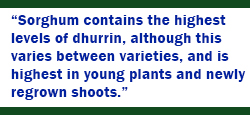
Proper summer annual forage harvest methods
 By Steve Murty, Vita Plus forage products specialist
By Steve Murty, Vita Plus forage products specialistI have heard this spring’s planting season referred to as “the spring that would never end.” It is apparent we will soon enter an extended forage harvest due in part to the length of the planting window and multiple alternative forages utilized. The resilience of our livestock producers would not allow anyone to give up on achieving some amount of forage production on an acre this year. The 2019 growing season gave us the opportunity to plant several new forages that not everyone was accustomed to growing or harvesting.
An unfamiliar challenge
Before we get to a harvest discussion, I first need to mention the compound dhurrin, which is prevalent in sorghum and sudangrass plants. When dhurrin breaks down, it releases prussic acid, or hydrogen cyanide, which can lead to prussic acid poisoning when consumed in high amounts. Sorghum contains the highest levels of dhurrin, although this varies between varieties, and is highest in young plants and newly regrown shoots. It is important to note, sudangrass rarely affects animals due to dhurrin. With proper management, any negative effects can be avoided.
 In general, it is recommended to not cut or graze these crops until the plant is 18 to 20 inches tall. Additionally, harvesting or grazing immediately after a killing frost should be avoided for 72 to 96 hours. This harvest delay after a frost is for the green vegetation to cure and allow the compound to exit the plants. During drought conditions, applying high-nitrogen fertilizer or manure will increase the risk of prussic acid poisoning, as well as nitrate poisoning. Hay and silage are seldom toxic, even if the original forage was, because the crop has dried or fermented, which releases the nitrate. Green-chopping a frost-damaged crop has the highest risk of prussic acid poisoning, and initial heating will increase the likelihood of toxicity in the feed.
In general, it is recommended to not cut or graze these crops until the plant is 18 to 20 inches tall. Additionally, harvesting or grazing immediately after a killing frost should be avoided for 72 to 96 hours. This harvest delay after a frost is for the green vegetation to cure and allow the compound to exit the plants. During drought conditions, applying high-nitrogen fertilizer or manure will increase the risk of prussic acid poisoning, as well as nitrate poisoning. Hay and silage are seldom toxic, even if the original forage was, because the crop has dried or fermented, which releases the nitrate. Green-chopping a frost-damaged crop has the highest risk of prussic acid poisoning, and initial heating will increase the likelihood of toxicity in the feed.
Understanding the compound dhurrin will help you understand the harvest options for these crops. These crops can be harvested in one of three ways: silage, wet bale and grazing.
Silage
These alternative forages can be chopped, packed, and ensiled as silage or baleage. Sorghum grasses should be harvested for ensiling at the soft dough stage to achieve the ideal moisture of 62% to 65%. For heading types, harvesting at the soft dough stage achieves the highest tonnage per acre while maintaining quality. The maturation of the seed head berries will help the entire plant dry down. Non-heading types usually require a killing frost or extended growing season with a dry period to achieve the ideal moisture.
These silage products have a similar feed value to corn silage, but the difference is in available energy due to the lower grain-to-forage ratios. Grain-head-producing forages, like corn, form starch, and the male sterile forages will not produce grain alone. In addition, the seed head berries become very hard when they mature and are difficult to process, making the starch less available to the gut and more readily passed through the animal undigested. Crude protein will vary more and is driven by the amount of nitrogen fertilization.
Wet baled
This option is best-suited for multiple-cut sorghum and sorghum-sudangrass varieties. The biggest mistake made when harvesting multiple-cut varieties is allowing the crop to get too tall. The large amount of biomass becomes more than the equipment can handle and requires multiple passes to turn the product, which will increase the ash content of the feed. It is best practice to target the first harvest 45 to 60 days after planting, or when it reaches 30 inches tall. The forage will need to be swathed to achieve ideal moisture levels for ensiling and wet wrapping. If a second cutting is desired, a minimum of 6 inches of stubble should be left to allow for regrowth to occur from the nodes.
Grazing
Grazing can occur at 45 days of growth, or at a minimum height of 24 inches. A high stocking density should be targeted to allow the animals to harvest the leaves quickly to limit the amount of hoof traffic damage to the plants. Taking half and leaving half of the entire stem will encourage faster recovery.
During times of adversity, new options can be discovered to produce milk or meat and achieve your production goals. Following these simple harvest strategies will put the most available nutrition into the silo. Contact your Vita Plus consultant if you have any questions about harvesting these unique forages this harvest season.
| Category: |
Crop varieties Forage Foundations Forage harvesting |

